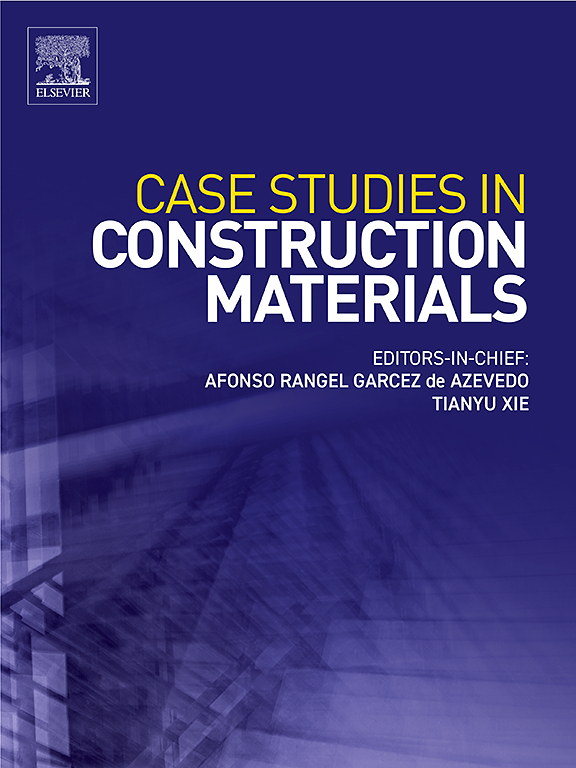Evaluation of compressive strength of eco-friendly cementitious composites incorporating waste oyster shells under sodium chloride solution exposure
IF 6.6
2区 工程技术
Q1 CONSTRUCTION & BUILDING TECHNOLOGY
引用次数: 0
Abstract
The development of the marine industry and the continuous increase in oyster production have caused the accumulation of large quantities of waste oyster shells, with only a small portion being recycled. Unrecycled waste oyster shells cause environmental problems, produce odors, and harm marine ecosystems. Simultaneously, aggregates such as sand are in high demand in the construction industry. Waste oyster shells, primarily comprising calcium carbonate (CaCO₃), have similar material characteristics to sand and can be used as a sand substitute. In this study, oyster shell cementitious composites were produced to assess the potential of waste oyster shells as a sand replacement. The experimental parameters included the use of admixtures, curing in either fresh water or sodium chloride solution, and various curing durations. The specimens were cured for 91 days in fresh water and 30, 60, or 91 days in sodium chloride solution. Nine oyster shell cementitious composite specimens measuring 50 mm × 50 mm × 50 mm were fabricated for each experimental condition, resulting in a total of 144 specimens. When cured in sodium chloride solution, the compressive strength decreased as the curing time increased, while the compressive strengths cured in fresh water and sodium chloride solution for 91 days were 38.8 and 34.55 MPa, respectively. Thus, the specimens cured in sodium chloride solution retained more than 80 % of the strength of those cured in fresh water. Therefore, waste oyster shells can serve as an eco-friendly construction material and are a viable alternative to sand.
含废牡蛎壳的环保胶凝复合材料在氯化钠溶液下的抗压强度评价
海洋产业的发展和牡蛎产量的不断增加,造成了大量废弃牡蛎壳的堆积,只有一小部分被回收利用。未回收的废弃牡蛎壳会造成环境问题,产生异味,危害海洋生态系统。同时,建筑行业对沙子等骨料的需求量很大。废弃的牡蛎壳,主要由碳酸钙(CaCO₃)组成,具有与沙子相似的材料特性,可以用作沙子的替代品。在本研究中,我们制作了牡蛎壳胶凝复合材料,以评估废弃牡蛎壳作为沙子替代品的潜力。实验参数包括外加剂的使用,在淡水或氯化钠溶液中养护,以及不同的养护时间。标本在淡水中固化91天,在氯化钠溶液中固化30、60、91天。每种实验条件下制备了9个尺寸为50 mm × 50 mm × 50 mm的牡蛎壳胶凝复合材料试件,共144个试件。在氯化钠溶液中养护时,抗压强度随养护时间的延长而降低,而在淡水和氯化钠溶液中养护91 d的抗压强度分别为38.8和34.55 MPa。因此,在氯化钠溶液中固化的试样保持了淡水中固化的强度的80% %以上。因此,废弃的牡蛎壳可以作为一种环保的建筑材料,是沙子的可行替代品。
本文章由计算机程序翻译,如有差异,请以英文原文为准。
求助全文
约1分钟内获得全文
求助全文
来源期刊

Case Studies in Construction Materials
Multiple-
CiteScore
7.60
自引率
19.40%
发文量
842
审稿时长
63 days
期刊介绍:
Case Studies in Construction Materials provides a forum for the rapid publication of short, structured Case Studies on construction materials. In addition, the journal also publishes related Short Communications, Full length research article and Comprehensive review papers (by invitation).
The journal will provide an essential compendium of case studies for practicing engineers, designers, researchers and other practitioners who are interested in all aspects construction materials. The journal will publish new and novel case studies, but will also provide a forum for the publication of high quality descriptions of classic construction material problems and solutions.
 求助内容:
求助内容: 应助结果提醒方式:
应助结果提醒方式:


